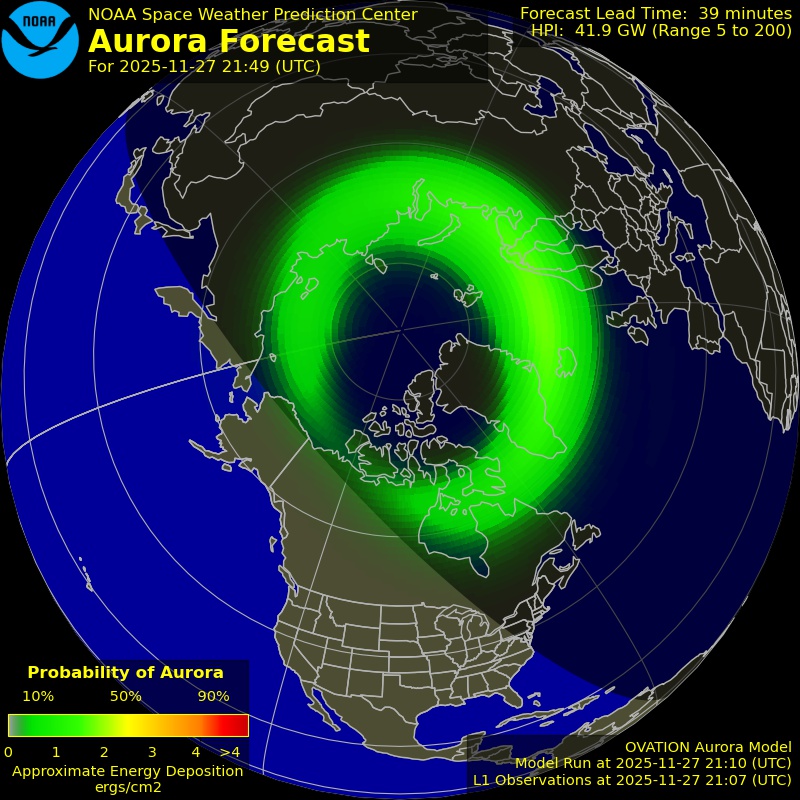Northern Lights Forecast for United States
Ideal Conditions for Northern Lights in the United States:
Power: +60 Gw | Bz: -10 | Wind Speed: 400+ | Density: 4+ | Kp: 5+
Auroras have been known to show in the norther states of the USA. The ideal conditions set above is for the Upper MidWest USA. Stronger data may be required for more southern cities.
Don’t Miss the Magic!
Stay ahead of the Northern Lights with real-time alerts. Subscribe now to receive a text or call whenever the aurora is active—so you never miss a moment of the show.
How to use this data:
If you're eager to witness the breathtaking northern lights in the United States, our tool serves as a valuable source for predicting aurora occurrences. We collect live satellite data and present it in a user-friendly dashboard, carefully filtering out unnecessary noise. However, we understand that interpreting the data may be perplexing. To make the most of this tool, follow our comprehensive “how-to” guide, which provides detailed information on effectively utilizing the data.
Leveraging the Long-Range Forecast:
To enhance your aurora-chasing adventure, take advantage of our long-range forecast feature. With this tool, you can plan your outings well in advance, giving you ample time to prepare for the mesmerizing spectacle of the northern lights. But that's not all – we go the extra mile to offer minute-to-minute insights for a more personalized and immersive experience.
What Are The Best Places to See the Northern Lights in the USA?
The best places to see the Northern Lights in the USA include Alaska, particularly in regions such as Fairbanks, Anchorage, and Denali National Park, where dark skies and high aurora activity offer prime viewing opportunities. Other potential locations include parts of northern Minnesota, North Dakota, and Michigan, where the lights can occasionally be visible during periods of strong solar activity and clear skies.
When Can You See the Northern Lights in the United States?
The best time to catch a glimpse of the northern lights in the USA is usually after dark, typically around 11:00 PM, and extending until 3 AM the next morning. However, on nights of exceptionally strong auroral activity, the northern lights may make an appearance much earlier, promising an awe-inspiring display for eager observers.
Best Time of Year for Aurora Borealis in the United States:
The Northern Lights can be seen in the United States during periods of strong solar activity and clear, dark skies. The best chances of witnessing the Northern Lights in the USA are typically during the fall and winter months when the nights are longer and darker. This means that from late September to early April, especially in regions closer to the Arctic Circle, there is a higher probability of experiencing the captivating dance of the Northern Lights in the American skies. However, sightings are not guaranteed, and various factors such as solar activity, weather conditions, and geographic location play a role in determining the visibility of this mesmerizing natural phenomenon.
How long do the Northern Lights usually last in the USA?
The duration of the Northern Lights, scientifically known as the Aurora Borealis, can vary significantly. On average, a single display of the Northern Lights may last anywhere from a few minutes to several hours. However, during periods of heightened solar activity and favorable atmospheric conditions, the auroras can persist for several hours, painting the night sky with an enchanting and mesmerizing spectacle. The exact duration of the auroras depends on various factors, such as the intensity of solar storms, atmospheric conditions, and the overall strength of the aurora display.
What to Expect?
When witnessing the captivating northern lights in USA, prepare to be dazzled by an array of colors dancing across the night sky. While the images of polar lights often depict vivid hues of green, pink, and purple, it's important to note that the naked eye might perceive a more subtle display. Expect to see beautiful white flashes or flickering, which might be mistaken for clouds. For a more vibrant and mesmerizing experience, capturing long exposures with a camera can reveal the true brilliance of the auroras. However, keep in mind that the colors you observe with your eyes may not perfectly match the striking tones seen in photographs. The enchanting dance of the northern lights is a unique and awe-inspiring spectacle that offers an unforgettable experience, regardless of the exact colors you perceive in the US night sky.
Aurora Oval
Northern Hemisphere

